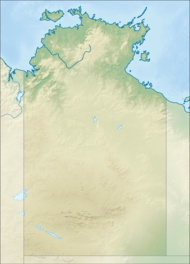Litchfield National Park
|
Litchfield National Park Northern Territory |
|
|---|---|
|
IUCN category II (national park)
|
|
| Nearest town or city | Adelaide River |
| Coordinates | 13°16′45″S 130°52′36″E / 13.27917°S 130.87667°ECoordinates: 13°16′45″S 130°52′36″E / 13.27917°S 130.87667°E |
| Established | 29 July 1991 |
| Area | 1,458.47 km2 (563.1 sq mi) |
| Managing authorities | Parks and Wildlife Commission of the Northern Territory |
| Website | Litchfield National Park |
| See also | Protected areas of the Northern Territory |
Litchfield National Park, covering approximately 1500 km2, is near the township of Batchelor, 100 km south-west of Darwin, in the Northern Territory of Australia. Each year the park attracts over 260,000 visitors.
Proclaimed a national park in 1986, it is named after Frederick Henry Litchfield, a Territory pioneer, who explored areas of the Northern Territory from Escape Cliffs on the Timor Sea to the Daly River in 1864.
Aboriginal people have lived throughout the area for thousands of years. It is important to the Mak Mak Marranunggu (northern portion), Werat and Waray (southern portion)Aboriginal people whose Ancestral Spirits formed the landscape, plants and animals and are still present in the landscape today.
The park was named after Frederick Henry Litchfield, a member of the Finniss Expedition that travelled from South Australia in 1864. This was the first European expedition to visit the Top End of Australia by land and it was their aim to explore as widely as possible and establish a settlement at Escape Cliffs, on the mouth of the Adelaide River. Previous attempts at settlement of Australia's northern coast at Fort Dundas, Raffles Bay and Port Essington had already failed.
The surveyor and soldier, Boyle Travers Finniss, was chosen by the South Australian government to be their government Resident in the Northern Territory. His decision to choose an area near Escape Cliffs for settlement was disastrous. The settlers suffered from inadequate food rations and infected mosquito bites. Finniss was disliked by the settlers who had accompanied him and argued with his officials.
The area which is now known as Litchfield National Park was first visited by Europeans in September 1865, when Litchfield led a small group to explore the Daly River. His diary of Monday, 25 September describes his travels:
...
Wikipedia

